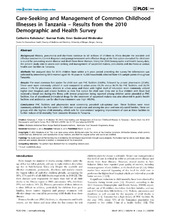| dc.contributor.author | Kahabuka, Catherine | en_US |
| dc.contributor.author | Kvåle, Gunnar | en_US |
| dc.contributor.author | Hinderaker, Sven Gudmund | en_US |
| dc.date.accessioned | 2013-06-14T09:59:01Z | |
| dc.date.available | 2013-06-14T09:59:01Z | |
| dc.date.issued | 2013-03-12 | eng |
| dc.Published | PLoS ONE 8(3): e58789 | eng |
| dc.identifier.issn | 1932-6203 | |
| dc.identifier.uri | https://hdl.handle.net/1956/6696 | |
| dc.description.abstract | Background: Malaria, pneumonia and diarrhoea continue to kill millions of children in Africa despite the available and effective treatments. Correct diagnosis and prompt treatment with effective drugs at the first option consulted for child care is crucial for preventing severe disease and death from these illnesses. Using the 2010 Demographic and Health Survey data, the present study aims to assess care-seeking and management of suspected malaria, pneumonia and diarrhoea at various health care facilities in Tanzania. Methods: We analyzed data for 8176 children born within a 5 years period preceding the survey.The information was collected by interviewing 5519 women aged 15–49 years in 10,300 households selected from 475 sample points throughout Tanzania. Results: The most common first option for child care was PHC facilities (54.8%), followed by private pharmacies (23.4%). These were more commonly utilized in rural compared to urban areas: 61.2% versus 34.5% for PHC facilities, and 26.5% versus 17.7% for pharmacies. Women in urban areas and those with higher level of education more commonly utilized higher level hospitals and private facilities as their first option for child care. Only one in four children with fever had received a blood test during the illness with lowest proportion being reported among children solely attended at PHC facilities. Use of abandoned antimalarial drugs for the treatment of suspected malaria was also observed in public health facilities and antibiotics use for diarrhoea treatment was high (49.0%). Conclusions: PHC facilities and pharmacies most commonly provided sub-optimal care. These facilities were more commonly utilized as the first option for child care in rural areas and among the poor and non-educated families. These are groups with the highest child mortality, which calls for interventions’ targeting improvement of care at these facilities to further reduce child mortality from treatable illnesses in Tanzania. | en_US |
| dc.language.iso | eng | eng |
| dc.publisher | Public Library of Science | eng |
| dc.relation.ispartof | <a href="http://hdl.handle.net/1956/6697" target="blank">Care seeking and management of common childhood illnesses in Tanzania</a> | eng |
| dc.rights | Attribution CC BY | eng |
| dc.rights.uri | http://creativecommons.org/licenses/by/2.0/ | eng |
| dc.title | Care-Seeking and Management of Common Childhood Illnesses in Tanzania – Results from the 2010 Demographic and Health Survey | en_US |
| dc.type | Peer reviewed | |
| dc.type | Journal article | |
| dc.description.version | publishedVersion | en_US |
| dc.rights.holder | Copyright 2013 Kahabuka et al | |
| dc.identifier.doi | https://doi.org/10.1371/journal.pone.0058789 | |
| dc.identifier.cristin | 1030376 | |
| dc.source.journal | PLoS ONE | |

